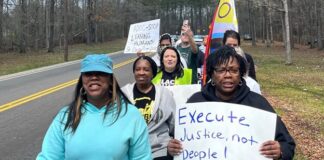
Part One: Every Treasure Islander has the right to know the names of the radiation, chemicals and heavy metals present in their unit and buried beneath and around their townhouse and in the common areas between homes.
by Carol Harvey
Foreword: I’m writing this article for Treasure Islanders who need the information, San Franciscans who own the island, and cogniscenti who understand that events on this decommissioned toxic naval base have national and global implications.
Worried mother
At a June 18, 2019, Treasure Island meeting, a worried mother reported that her townhouse facade had sprouted a metal sign bearing a frightening message: “This area contains chemicals known to the State of California to cause cancer, birth defects, or other reproductive harm.”
On June 10, she and her teenage daughter exited their townhouse. This sign, with no forewarning, “was just there.” “And she’s like – WHAT?
“Three quarters of the island’s population consists of people of color perpetually exposed to toxins.”
“And I snapped a photo, because I just couldn’t believe my eyes. I’ve been very concerned since then – and so has she.”
The mother was deeply troubled because “our children live here, and there are like 20 kids playing out in front on any given weekend. And those parents with babies in arms are coming out, and they’re seeing this sign.
“My child is going to be pregnant, maybe, if she’s blessed. Someday, laying there in bed – the women who’ve had babies – you think of everything. And she’s going to think back on these days.
“So, I need answers.”
As of this publication date, similar notices have been affixed to other townhouses. Some islanders have seen no signs.
Our anonymous “worried mother” addressed the Treasure Island Restoration Advisory Board during public comment at meeting No. 188 held in Room 117 on the first floor of the Administration Building, One Avenue of the Palms.
The RAB is an 11-member community group, most of whose members do not live on the island, but for whom the Navy, nevertheless, updates its progress on the environmental cleanup of this artificial landform in San Francisco Bay, which it polluted for 51 years.


Many islanders do not know that, between 1941 and 1999, during and after World War II when the Navy established a base on the island, they deposited radiation, chemicals and the heavy metals mercury, lead and arsenic in its soil and groundwater.
Radioactive contamination occurred when the Navy conducted nuclear schools from which sailors were sent marching with geiger counters across the 404-acre island in a sort of treasure hunt searching out radium-226 pieces buried in the dirt.


After the Navy incinerated trash in burn pits at the southwestern end of the island facing the Golden Gate Bridge In the ‘40s and ‘50s, chemicals and heavy metal byproducts remained in the soil. Burning converted the refuse into an array of toxic chemicals. Navy Seabee tractors graded the earth. Between 1965 and 1985, the Navy contracted Napa Valley builder Actus-Sundt JV to construct townhouses there for sailors’ families.
Since 1993, Treasure Island, a radiologically and chemically toxic EPA-designated Superfund site (ID CA7170023330), has been undergoing environmental cleanup by the Navy.
Despite this, the John Stewart Co. and a nonprofit collaboration, One Treasure Island, sublet townhouses on this contaminated ground from the Navy. John Stewart’s The Villages provides inexpensive market rate apartments to escapees from San Francisco’s astronomical rents, and One Treasure Island extends supportive programs in subsidized units to formerly homeless citizens.
Three quarters of the island’s population consists of people of color perpetually exposed to toxins, an unlawful condition opening the Treasure Island Development Authority (TIDA) and One Treasure Island to accusations of environmental racism.
The Navy has cleaned and transferred most of the island to the City. Until it completes the remediation of Site 12, the island’s most polluted section, it cannot transfer ownership of the land on which people are housed.
Though it subleases Site 12 to TIDA, the Navy is the primary title-holder. Despite tiers of sublessees, Navy ownership of Site 12 renders it ultimately responsible for toxins in soil, remediation zones, common areas, buildings and the land they sit on.
“Worried mother” recalled that in 2014, “we had the radiological study done at our place, and we were told we were cleared.” Because the Navy seemed to be “protecting us and doing their due diligence,” she reassured her child, “We’re OK.”
She reported, however, that when she requested protective dust monitors “in our area,” Navy personnel told her, “‘Oh, yeah! We have lots of them.’ But later that week they called me and said, ‘We can’t do that.’”
“And, since then – before then – I had developed asthma and COPD living here.” Chronic obstructive pulmonary disease causes chest tightness. She struggles for breath. “So, I’m very concerned about it – the air and the toxins.”
Unexpected warning signs could trigger confusion and fear in adults and children who for three generations have passed yellow metal radiation triangles on chain link fences shrouded by flapping green tarps in which high winds have blown tattered holes.

Earthmovers crawled back and forth inside radiation zones mere feet from their homes. Trucks hauled away load after load of radioactive soil, trailing wet tracks down their streets. Yet, for 20 years, the Navy reassured them the island was a safe place to live.

Was this new signage a cruel withdrawal of former guarantees? Was the Navy reversing course and admitting the poisonous truth: Treasure Island is toxic?
Carol Harvey is a San Francisco political journalist specializing in human rights and civil rights. She can be reached at carolharvey1111@gmail.com.

 Store
Store



